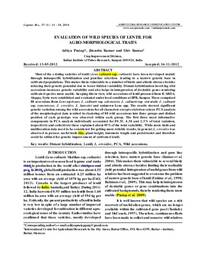Evaluation of wild species of lentil for agro-morphological traits

Authors:
Most of the existing varieties of lentil (Lens culinaris ssp. culinaris) have been developed mainly
through intraspecific hybridization and pureline selection leading to a narrow genetic base in
cultivated populations. This makes them vulnerable to a number of biotic and abiotic stresses besides
reducing their genetic potential due to lesser hidden variability. Distant hybridization involving wild
accessions increases genetic variability and also helps in introgression of desirable genes rendering
cultivated species more usable. Keeping this in view, wild accessions of lentil procured from ICARDA,
Aleppo, Syria were established and evaluated under local conditions at IIPR, Kanpur. These comprised
88 accessions from Lens nigricans, L. culinaris ssp. odemensis, L. culinaris ssp. orientalis, L.
culinaris ssp. tomentosus, L. ervoides, L. lamottei and unknown Lens spp. The results showed significant
genetic variation among the wild accessions for all characters except cotyledon colour. PCA analysis
of the morphological data resulted in clustering of 88 wild accessions into three groups and distinct
position of each genotype was observed within each group. The first three most informative
components in PCA analysis individually accounted for 89.35, 4.38 and 2.3% of total variation,
respectively and collectively these explained about 95% of the total variability. While more traits and
multilocation data need to be considered for getting more reliable results, in general L. ervoides was
observed to possess useful traits like plant height, internode length and pods/cluster and therefore
could be utilized for genetic improvement of cultivated lentil.
